|
|
|
|
Because Hooghuys organs dispose of a peculiar mechanism – which
allows the accurate repetition of small holes in the cardboard – Hooghuys
arrangements are mostly easy to recognize, because they tend to
use these small holes quite often. However, the old Hooghuys arranging
style can be recognized even without those small holes: it is rather
simple (even a little 'thin' compared with today's popular styles)
but it often has an elaborated countermelody, and much attention
is paid to the use of the registers.
Taking into account the period when Hooghuys was active, it is
far from surprising that original Hooghuys factory books contain
music typical for the 1900-1920 era, with a preference for traditional
dances like the quadrille, march, polka, schottische, waltz and
mazurka. Of course, there are also the 'classics' which are
to be found in the repertoire of other organ builders too.
Hooghuys usually ordered a large number of scores from his supplier;
then a choice was made of all the scores, and those that were not
going to be used, were sent back. The score was usually completely
written out again as a specific organ arrangement, with separate
lines for the melody, countermelody, accompaniments and basses.
Several members of the Hooghuys family were active as arranger
(unlike Mortier, Hooghuys never took on external arrangers): Louis,
his brother Edgard and his son Charles (?), as well as Charles'
son Romain Charles. The pinning of barrels seems to have been the
job of Edgard only, though (also after Louis' decease).
Not only did family members make arrangements, they also composed
music themselves: Louis did very meritorious work, as well as
Charles and Romain Charles (with a.o. the "Tango del mamita" and
the "Eliane"-galop); further also Edgard' sons Raoul
and Achille. However, the most prolific composers in the Hooghuys
family were certainly Edmond and Edgard himself: it is even hard
to guess how many tunes sprung from their creative minds. Their
compositions can mostly be categorized as 'short dance tunes' (often
without title), and they were created primarily for barrel organs.
Some examples:
- Edmond Hooghuys: Marche des propagandistes, Triomphe (march),
Le petit galant (march), Brise légère (schottische), …
- Edgard Hooghuys: Bettina (redowa), Tentoonstellingsecho's (polka),
L'étoile d'or (schottische), Paulette (polka), Sonnez clairons
(quadrille), …
Most of the repertoire has obviously been destroyed in due course
(old tunes had to be replaced with new 'hit songs', and old books
(and barrels) often ended up in the stove) but most Hooghuys
organs still have a unique repertoire that cannot be compared to
that of e.g. Mortier organs, which often have a post-WWII repertoire.
|
|
|
| |
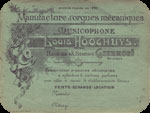 |
|
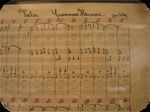 |
|
 |
|
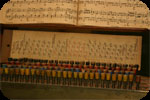 |
|
| |
Book label
of
Louis Hooghuys |
|
Detail
of the score of the "Valse kermesse Grammont" by Edgard Hooghuys,
with separate lines for melody, countermelody, … |
|
Hooghuys
scale strip as used on the
arranging drum. |
|
Detail
of the arranging drum used by Edgard and later by
Romain Charles Hooghuys. |
|
|
|
|
|
|
|
|
|
|
|
|
|
| |
 |
|
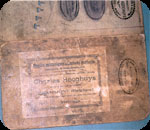 |
|
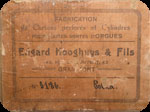 |
|
 |
|
|
Detail
of the list of arranged barrels, with mention of the composer
of the tune as well as the scale and/or owner of the organ.
Some arrangements were later re-used for book organs: the
book number (preceded by "c.(no.)" is then added
to the barrel number. |
|
Book label
with stamp of Charles Hooghuys. |
|
Book
label of Edgard Hooghuys and son (Victor), dating from after
Louis' decease (1924), when Edgard was a self-employed arranger
and 'barrel pinner'.
The label mentions the number of the arrangement (no title!)
and the music genre.
|
|
More
recent book label of Edgard Hooghuys. The addition "and son"
has been left out. |
|
|
|
|
| |
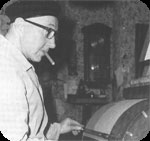 |
|
 |
|
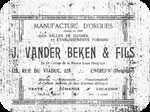 |
|
| |
Romain
Charles Hooghuys – with the inevitable cigar – at the
arranging drum. |
|
Book label
of Romain Charles Hooghuys. The year "1780" is erroneous:
it should obviously read "1880". |
|
Some
organs also have books in their repertoire that were deliverd
by the former Hooghuys employee Julius Vander Beken. However,
it is unclear if Vander Beken arranged the books himself
(or employed an arranger in his factory) or ordered them
from others and just glued his label on them. |
|
|
|
|
Not only Hooghuys family members have made arrangements
for Hooghuys organs: later, you also had famous Belgian arrangers
like Eugène Peersman, Urbain Van Wichelen and Arthur Prinsen.
But the most esteemed and prolific arranger for Hooghuys
organs was undoubtedly August Schollaert from Aalst (1893-1958).
Schollaert started with arranging for Mortier organs, but
it didn't take look before – with the help and support
of Edmond Hooghuys – he also marked music for Hooghuys
organs. His most popular arrangements are those for the 70-key
fair organs (esp. the one of Becquart): the English periodical
"Gramophone" even wrote that his arrangement of the overture
to "Die schöne Galathee" (F.von Suppé) was to be taken as
"an example by orchestras"!
It might be interesting to know that Schollaert never marked
his music on pattern paper but always directly on cardboard.
The number of books he made, is uncountable (fortunately,
his wife Aline and son Herman assisted him in cutting the
books). Of course, not all of his arrangements are outstanding,
but most of his books are among the best ever made.
In more
recent times, other arrangers have also delivered new books
for Hooghuys organs: e.g. the Dutch arrangers Jan Kees
de Ruijter, Tom Meijer and Frans Stal. By his fine arrangements
(esp. for Hooghuys fair organs), Filip Neirinck from Sint-Amandsberg
(B) has also won his spurs in recent years. Special mention should also be made of Kevin Meayers (UK), who has been marking music for Hooghuys organs since 1985 in England and abroad.
|
|
|
|
| |
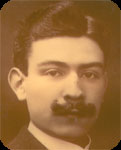 |
|
 |
|
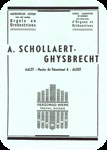 |
|
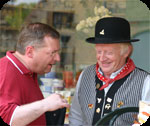 |
|
|
August Schollaert (1893-1958) |
|
Book label
of Schollaert, with
the address "Kluyskensstraat 20" . |
|
More recent
book label of August Schollaert with the address "Nestor
de Tièrestraat 6". |
|
Filip
Neirinck with
Norbert Vroman
(owner of LH522).
|
|
|
|
